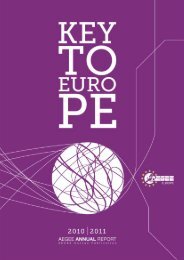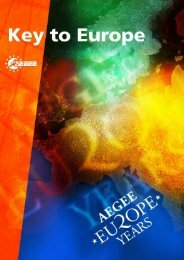turkish-greek civic dialogue - AEGEE Europe
turkish-greek civic dialogue - AEGEE Europe
turkish-greek civic dialogue - AEGEE Europe
You also want an ePaper? Increase the reach of your titles
YUMPU automatically turns print PDFs into web optimized ePapers that Google loves.
your government?” The peasant repeats, “Of course”. “How about two cars?”<br />
“Yes, of course. Who else do I have other than my government?” and similar<br />
questions follow one another. Finally, the statesman asks, “If you had two hens,<br />
would you grant one? And the peasant says, “No”. When the statesman asks for<br />
the reason, the peasant replies, “Because I do have two hens.”<br />
This is surely a fictional story by Occidental authorities to criticize the<br />
infrastructure of socialist order.<br />
I shared this anecdote because in the panel speeches or some sources there were<br />
some different discourses upon positional conflicts between the good and bad<br />
sides of the state of war, which are probably not recollected in a correct way<br />
any more and distorted by false memories. These objective subjects in front<br />
of us are not only architectural matters but also matters on the consequences<br />
of all kinds of concrete cultural property. However, we do not behave like the<br />
peasant in the anecdote, which is very important. We still keep our positions.<br />
The meaning of all of these - the property belonging to people exchanged<br />
between two countries and the period during which exchange was done<br />
between the two countries - is important.<br />
In the 1970’s, the countries in the region accepted the Venice Agreement of the<br />
1960’s. Between 1890 – 1891, An Austrian author Regal wrote on how to take<br />
values into consideration. Undoubtedly, many philosophers had dealt with the<br />
value of the logic before Regal did, however the first time we come across with<br />
the descriptions in the agreements in force today is when we look at Regal’s<br />
writings. It does not have a long history; 150 years. Thus, we can reflect on<br />
what is collective value, what is historical value, what might permanency be<br />
through his historical classification. The West has fallen behind in the sense<br />
of the articulation and elaboration of all these concepts or defending them in<br />
the field.<br />
We, especially our intellectual community, can discuss about anything whereas<br />
we are not aware of what we possess in an objective way. I do not say that<br />
there has not been any investigation into the exchange in Turkey but the studies<br />
on the issues I want to mention here can be regarded as the first ones in this<br />
field.<br />
Association des Etats Généraux des Etudiants de L’<strong>Europe</strong><br />
Kemal Arı and Nedim İpek of Turkish History Institution, among many other<br />
researchers, have studied the documents of the great exchange. This study<br />
has been completed in about three years through scanning 10557 documents as<br />
financed by the Land Housing General Directorate at the Republic archives. But<br />
how did Turkish Republic deal with it?<br />
There is a document from an archive which was opened in 1998. This document<br />
is a thrilling one for me as it is the first visual material I obtained coincidentally<br />
while I was doing research for some other two studies. Having been victorious<br />
after a war which passed in poverty and debts, Turkish Republic was able to<br />
become organised and prepare three different sheltering and housing policies.<br />
One of them is to build up ready-made huts. We must be objectively aware of<br />
what we have pertaining to past and today.<br />
The result is interesting; there are Ministry sub-directives for ready-made hut<br />
import for places having access to import harbours and buildings of reed-dried<br />
mud mixture in places far from the import harbours. The second housing type<br />
is economic houses in which houses are built for individuals or groups of small<br />
number of people where a family is to accommodate or for bigger number of<br />
people who had to be accommodated or located there.<br />
Therefore a sample village consists of 52-54 houses inside of which are a<br />
market, a mosque, a school, a fountain and outside of which are a cemetery,<br />
a harvesting, a halo. The third reaction is the article we found in the achieves<br />
makes use of “enval-i metruke”, that is to say “abandoned property”.<br />
At first, the use of enval-i metruke houses remaining from the Armenian and<br />
the Greek of Turkish nationality by state employees was encouraged for about<br />
eight-ten months, especially in Ankara where enval-i metruke was abundant.<br />
Later, however, it turned out that there could be inconveniencies regarding the<br />
treaty; thus, making use of enval-i metruke was ceased and the residents of<br />
these houses were asked to evacuate their residences. Today we do not know<br />
clearly at what rate this evacuation initiative was successful but there are<br />
documents showing that residence in enval-i metruke continued illegally. Just<br />
as we try to evacuate the shanty houses today, they also tried to evacuate the<br />
enval-i metruke at that time.<br />
The exchange documents shed light on the issue regarding the architecture<br />
history with some directives and circulars. These documents include detailed<br />
Population Exchange<br />
147







